The Zoological Museum
Michael Vladimirovich Yurakhno, Professor, Dr.Sci.Biol. Phone: +38 (0652) 60-81-65 The museum is formed in 1965 at the initiative of the world famous zoologist, researcher of sea mammals helmints, professor S.L.Delyamure. The greatest contribution to its creation and development was made by: honoured worker of culture of Ukraine M.I.Globenko heading the museum for forty years, professors: A.S.Skryabin and M.V.Yurakhno, present manager I.N.Grishchenko, senior lecturer A.A.Stryukov, assistants V.V. Solovyev and D.B. Startsev, the senior laboratorians I.M.Taykov, V.A.Kuznetsov and student R.Lapin.
Exhibits are collected by employees of the Department of Zoology in 62 scientific expeditions in various areas of the planet, including the most remote water areas of Arctic and Antarctic. The first scientific expedition was made by prof. S.L.Delyamure in 1939. He investigated helmints of the Azov-Black Sea dolphins and found new kinds of parasitic helmints – nematode – which he called Halocercus taurica, H. ponticus and H. kleinenbergi. The Antarctic The great value for the museum is collection of spiders made by associate professor N.M.Kovblyuk. There are about 80 thousand exhibits in it, including 12 new species. Exhibits from expeditions were delivered to Simferopol with extreme difficulties, sometimes with risk for life. Then they were mounted by skilful hands of taxidermists in the museum which gradually turned into the exposition of animals from all climatic zones of Earth. 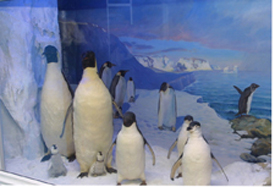
Abundance of the highly artistic insonified dioramas gives special appeal to the museum. They look like windows in the wildlife. In the diorama "Arctic regions" visitors see rocky coast of Chukotka, the icy Chukotka Sea with seals and walruses. Shouts of seagulls, dolphins, "song" of a humpbacked whale, underwater location of a walrus are heard. In the foreground – a female walrus with a cub, delivered by prof. M.V.Yurakhno from Alaska. It is a unique exhibit of this animal in the museums of Ukraine. Before the diorama, on a ceiling the bottom jaw of a cachalot brought by prof. A.S.Skryabin from Antarctic is mounted. In the diorama "The Antarctic" the sea leopard, a crab-eater seal, a seal of Weddell are presented, all impressing with their sizes. The sounds of the largest representative of pinnipeds – a sea elephant are heard. The weight of large males reaches five tons. Heat and light are in the air at "African Savanna" diorama. Elephants blare, lions roar, hyenas guffaw. The highest mountain of Africa – Kilimanjaro serenely rises in the sky on the horizon. The diorama "Tropical Island" provides guidance on variety of sea turtles (green turtle, platycephalous, coriaceous, etc.) and vociferous feathery inhabitants of this climatic zone: frigates, gannets, tropicbirds. Sea fishes are numerous in the museum: in dioramas of coral islands, and at special stands. The diorama "The Crimean Natural Reserve" does not leave you Museum reconstruction has not been finished yet. In the plans of the museum – creation of a new exposition of invertebrate animals – protozoa, sponges, anthozoans, worms, mollusks, Crustacea, spiders, insects, echinoderm, etc. The big paleontologic material which will recreate the remote past of our peninsula has been collected. More than 5 thousand students, schoolboys and guests of Crimea visit the museum annually. It has turned into the popular scientific-educational centre of republican significance. |
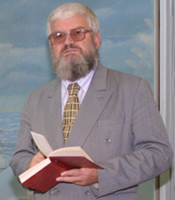 Director
Director 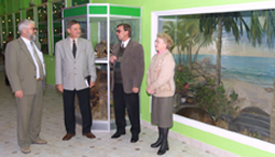 Last reconstruction was carried out in 2003, thanks to the help of the Rector of the University professor N.V.Bagrov.
Last reconstruction was carried out in 2003, thanks to the help of the Rector of the University professor N.V.Bagrov.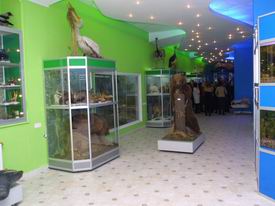 expeditions of prof. A.S.Skryabin (1963-1964 and 1965-1966) and prof. M.V.Yurakhno (1986-1987) were the most valuable. 2006 whales and 364 seals were investigated. Unique helminthological material was collected, interesting museum pieces were found. More than 10000 sea animals have been dissected in total by the employees of the Department, 65 new species of helmints have been described, 7 new kins and 6 new families have been grounded. Some investigations have value for whole biology. For example, prof. A.S.Skryabin described the largest cestoda Polygonoporus giganticus (more than 30 m long), and prof. M.V.Yurakhno – the most prolific cestoda: Baylisia supergonoporis (up to 307 sexual complexes in each segment of the body).
expeditions of prof. A.S.Skryabin (1963-1964 and 1965-1966) and prof. M.V.Yurakhno (1986-1987) were the most valuable. 2006 whales and 364 seals were investigated. Unique helminthological material was collected, interesting museum pieces were found. More than 10000 sea animals have been dissected in total by the employees of the Department, 65 new species of helmints have been described, 7 new kins and 6 new families have been grounded. Some investigations have value for whole biology. For example, prof. A.S.Skryabin described the largest cestoda Polygonoporus giganticus (more than 30 m long), and prof. M.V.Yurakhno – the most prolific cestoda: Baylisia supergonoporis (up to 307 sexual complexes in each segment of the body).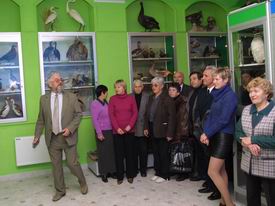 The diorama "Commander Islands" meets visitors with a many-voiced rookery. Rocks are literally covered with white-breasted kiddaws, guillemots (Fratercula corniculata, Lunda Pallas), cormorants, seagulls. Fur seals, eared seals, an island seal grumble below. Diorama "Penguins" is impressive. Hoarse voices of emperor, king, antarctic, crested penguins and other feathery inhabitants of the ice continent welcome tourists.
The diorama "Commander Islands" meets visitors with a many-voiced rookery. Rocks are literally covered with white-breasted kiddaws, guillemots (Fratercula corniculata, Lunda Pallas), cormorants, seagulls. Fur seals, eared seals, an island seal grumble below. Diorama "Penguins" is impressive. Hoarse voices of emperor, king, antarctic, crested penguins and other feathery inhabitants of the ice continent welcome tourists.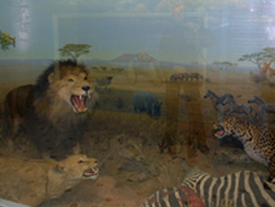 indifferent. In the morning wood sonorous voices of birds and a mighty roar of a red deer are audible. Black vultures and griffons added to the Red data book please an eye. These feathery giants are the real adornment of Crimean mountains.
indifferent. In the morning wood sonorous voices of birds and a mighty roar of a red deer are audible. Black vultures and griffons added to the Red data book please an eye. These feathery giants are the real adornment of Crimean mountains.